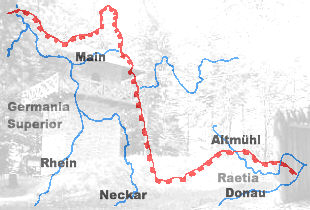|
Reichs-Limeskommission
The Imperial Limes Commission (german: Reichs-Limeskommission) or RLK, was set up to work out the route of the Upper Germanic-Rhaetian Limes, the Roman frontier north of the Alps, and the location of its associated Roman fort, forts at the time of the Roman Empire. It was the first institution to engage in a cross-border, historical project after German Unification in 1871. Introduction The Upper Germanic-Raetian Limes, constructed around 100 AD, has been a UNESCO World Heritage Site since 2005, and has been of interest in scholars since the 16th century as the outer border of the Roman Empire. Johannes Aventinus, Aventinus (fl.1500) was the first to deal with a presumptive part of the limes at Eichstätt, which he ascribed to the Emperor Probus (emperor), Probus. Until the 19th century, theories were repeatedly proposed about the Limes. Special mention is deserved by Christian Ernst Hanßelmann, who recognized connections between the Rhaetian wall in Bavaria and remains of walls ... [...More Info...] [...Related Items...] OR: [Wikipedia] [Google] [Baidu] |
Upper Germanic-Rhaetian Limes
The Upper Germanic-Rhaetian Limes (german: Obergermanisch-Raetischer Limes), or ORL, is a 550-kilometre-long section of the former external frontier of the Roman Empire between the rivers Rhine and Danube. It runs from Rheinbrohl to Eining on the Danube. The Upper Germanic-Rhaetian Limes is an archaeological site and, since 2005, a UNESCO World Heritage Site. Together with the Lower Germanic Limes it forms part of the ''Limes Germanicus''. The Limes used either a natural boundary such as a river or typically an earth bank and ditch with a wooden palisade and watchtowers at intervals. A system of linked forts was built behind the Limes. Terminology The term ''limes'' (plural: ''limites'') originally meant "border path" or "swathe" in Latin. In Germany, "Limes" usually refers to the Rhaetian Limes and Upper Germanic Limes, collectively referred to as the ''Limes Germanicus''. Both sections of ''limes'' are named after the adjacent Roman provinces of ''Raetia'' (Rhaetia) and ' ... [...More Info...] [...Related Items...] OR: [Wikipedia] [Google] [Baidu] |

